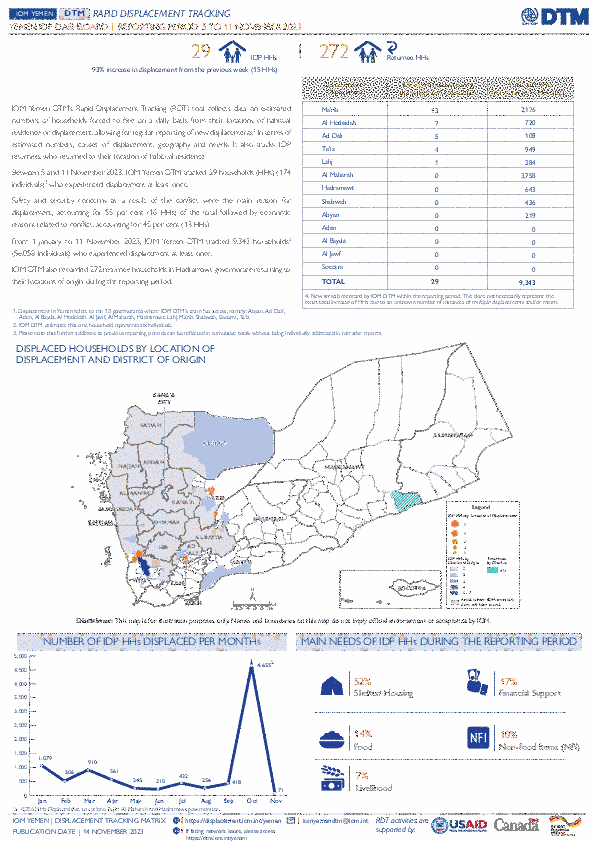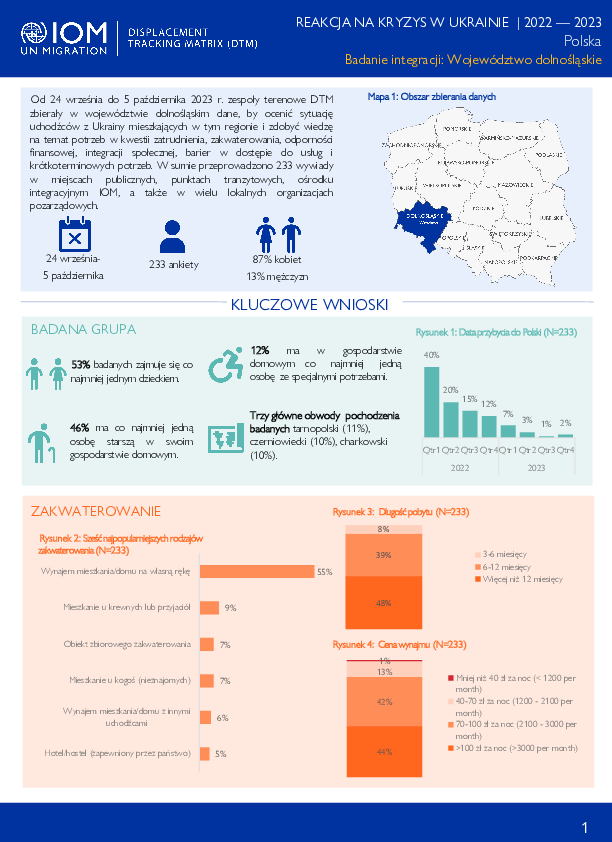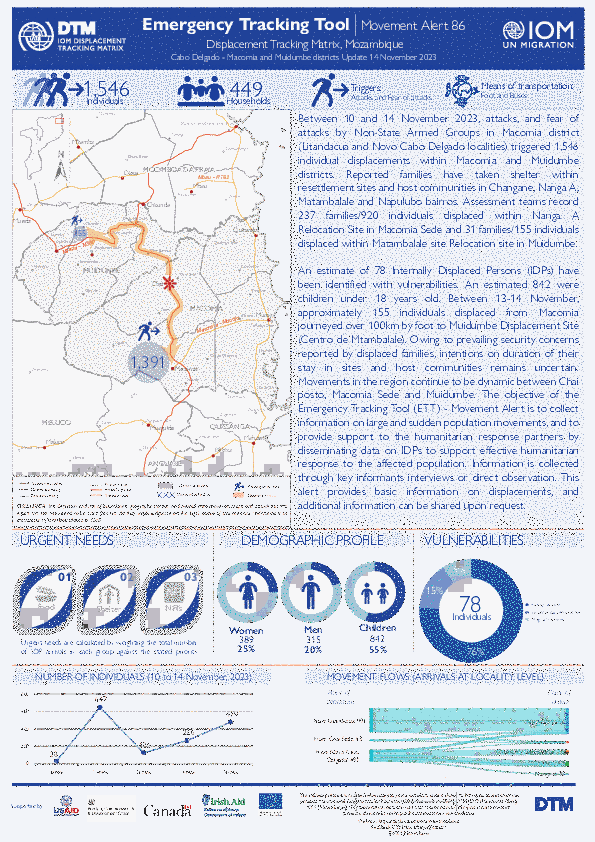-
Countries
-
Data and Analysis
-
Special Focus
-
Crisis Responses
Contact
DTM Yemen, iomyemendtm@iom.int
Location
Yemen
Activity
- Mobility Tracking
Period Covered
Nov 05 2023 -Nov 11 2023
From 1 January to 11 November 2023, IOM Yemen DTM tracked 9,343 households (HH) (56,058 Individuals) who experienced displacement at least once.
Between 5 and 11 November 2023, IOM Yemen DTM tracked 29 households (174 individuals) displaced at least once. The majority of people moved into/within the following governorates and districts:
- Ma’rib (13 HHs) – Ma’rib (9 HHs), Ma’rib City (2 HHs), Harib (2 HHs) districts. Most displacements in the governorate originated from Ma’rib and Shabwah.
- Al Hodeidah (7 HHs) – Hays (5 HHs), Al Khukhah (2 HHs) districts. Most displacements in the governorate originated from Al Hodeidah and Ta’iz.
- Ad Dali (5 HHs) – Ad Dali (3 HHs), Al Hasayn (2 HHs) districts. Most displacements in the governorate originated from Al Hodeidah and Ad Dali.
- Ta’iz (9 HHs) – Maqbanah (7 HHs), As Silw (1 HH), Al Mawasit (1 HH) districts.
- Al Hodeidah (6 HHs) – Zabid (2 HHs), Hays (2 HHs), Al Jarrahi (1 HH) districts.
- Ma’rib (3 HHs) – Al Jubah (2 HHs), Harib (1 HH) districts.
Population Groups
IDPs
Relocatees (previously internally displaced)
Returnee (Previously Displaced Abroad)
Survey Methodology
Unit of Analysis Or Observation
Admin Area 4
Site
Site or Location
Type of Survey or Assessment
Household
Key Informant
Keywords
Geographical Scope Partial Coverage
Administrative boundaries with available data
The current dataset covers the following administrative boundaries

Contact
DTM Yemen, iomyemendtm@iom.int
Language
English
Location
Yemen
Period Covered
Nov 05 2023
Nov 11 2023
Activity
- Rapid Emergency Registration
- Mobility Tracking
IOM Yemen DTM’s Rapid Displacement Tracking (RDT) tool collects data on estimated numbers of households forced to flee on a daily basis from their locations of origin or displacement, allowing for regular reporting of new displacements in terms of estimated numbers, geography, and needs. It also tracks returnees who returned to their location of origin.
From 1 January to 11 November 2023, IOM Yemen DTM tracked 9,343 households (HH) (56,058 Individuals) who experienced displacement at least once.
Between 5 and 11 November 2023, IOM Yemen DTM tracked 29 households (174 individuals) displaced at least once. The majority of people moved into/within the following governorates and districts:
- Ma’rib (13 HHs) – Ma’rib (9 HHs), Ma’rib City (2 HHs), Harib (2 HHs) districts. Most displacements in the governorate originated from Ma’rib and Shabwah.
- Al Hodeidah (7 HHs) – Hays (5 HHs), Al Khukhah (2 HHs) districts. Most displacements in the governorate originated from Al Hodeidah and Ta’iz.
- Ad Dali (5 HHs) – Ad Dali (3 HHs), Al Hasayn (2 HHs) districts. Most displacements in the governorate originated from Al Hodeidah and Ad Dali.
The majority of people moved from the following governorates and districts:
- Ta’iz (9 HHs) – Maqbanah (7 HHs), As Silw (1 HH), Al Mawasit (1 HH) districts.
- Al Hodeidah (6 HHs) – Zabid (2 HHs), Hays (2 HHs), Al Jarrahi (1 HH) districts.
- Ma’rib (3 HHs) – Al Jubah (2 HHs), Harib (1 HH) districts.

Contact
DTM Yemen, DTMYemen@iom.int
Language
English
Location
Yemen
Period Covered
Jul 01 2023
Sep 30 2023
Activity
- Flow Monitoring Survey
- Flow Monitoring
This dashboard compiles flow monitoring survey (FMS) data collected in Yemen between July and September 2023 and provides an analysis of migrants’ demographic and socio-economic profiles, including education and employment backgrounds, reasons for leaving their country of origin or habitual residence, future travel intentions, protection and challenges faced during the journey. Also included are migrants’ highest level of education achieved and their labour status prior to moving.
The migration routes in the southern part of Yemen are categorized along two main routes: the south-east route towards Shabwah, Hadramawt, and Al Maharah governorates and the north-east route towards Lahj and Ta’iz governorates. Both routes are traditionally travelled by a large number of migrants each year. Through the Flow Monitoring Registry tool, which focuses on total numbers of migrants (as opposed to the more detailed migrant profile established through the FMS).
DTM recorded 15,227 migrants entered Yemen through the south in the third quarter of 2023. This figure represents a significant decrease compared to the previous quarter, with nearly two thirds (62%) of all migrants were recorded in July. The remainder was recorded in August and September. The significant decrease observed since August is likely attributed to the ongoing joint military campaign initiated to combat smuggling and secure the coastline of Lahj, a well-known governorate for receiving the largest proportion of migrants. The campaign involved deploying troops, conducting raids, and establishing checkpoints.
During the third quarter of 2023, a total of 2,705 surveys were conducted. In Aden (667), Lahj (655), Ma’rib (487), Shabwah (409), Hadramawt (245) and Al Maharah (242). The overall number of surveys increased by one per cent over the previous quarter. The majority of respondents were young male adults between the age of 17 and 25 (78%) searching for economic opportunities (95%), most of whom were single (92%), attained primary education or less (60%), were currently unemployed (94%) and departed from rural areas (78%).

Contact
DTM Europe, DTMMediterranean@iom.int
Language
English
Location
Romania
Period Covered
Jul 01 2023
Sep 30 2023
Activity
- Survey
This report analysed data from a survey carried out between July and September 2023 (Quarter 3, Q3). The survey sample included 1,601 individuals who were crossing back to Ukraine, including 1,589 Ukrainian nationals and 12 Third-Country Nationals (TCNs). The analysis focuses on Ukrainian nationals.
- Top 3 countries of stay abroad: Romania (53%), Bulgaria (19%), Italy (5%).
- Top 3 oblasts of origin: Odeska (38%), Chernivetska (16%), Kyiv city (9%).
- Transport to Ukraine: car (68%), bus (14%), walking (10%), minibus (8%).
- Top areas of assistance received*: food (27%), sanitary supplies (19%), accommodation (18%), and financial support (17%).
- Top 3 needs upon crossing back*: financial support (26%), personal safety (19%), and food supply (17%).

Contact
DTM Poland, IOMDTMPoland@iom.int
Language
Ukrainian
Location
Poland
Period Covered
Sep 24 2023
Oct 05 2023
Activity
- Survey
- Return Intention
З 24 вересня по 5 жовтня 2023 року польові команди DTM збирали дані в регіоні Нижня Сілезія, щоб оцінити ситуацію українських біженців, які проживають у регіоні, та отримати інформацію про потреби в працевлаштуванні, житлі, фінансовій стійкості, соціальній інтеграції, бар'єри в доступі до послуг та короткострокові потреби. Загалом було проведено 233 інтерв'ю в громадських місцях, транзитних пунктах, інтеграційному центрі МОМ, а також з низкою місцевих НУО.

Contact
DTM Poland, IOMDTMPoland@iom.int
Language
English
Location
Poland
Period Covered
Sep 24 2023
Oct 05 2023
Activity
- Survey
- Return Intention
Od 24 września do 5 października 2023 r. zespoły terenowe DTM zbierały w województwie dolnośląskim dane, by ocenić sytuację uchodźców z Ukrainy mieszkających w tym regionie i zdobyć wiedzę na temat potrzeb w kwestii zatrudnienia, zakwaterowania, odporności finansowej, integracji społecznej, barier w dostępie do usług i krótkoterminowych potrzeb. W sumie przeprowadzono 233 wywiady w miejscach publicznych, punktach tranzytowych, ośrodku integracyjnym IOM, a także w wielu lokalnych organizacjach pozarządowych.

Contact
DTM Poland, IOMDTMPoland@iom.int
Language
English
Location
Poland
Period Covered
Sep 24 2023
Oct 05 2023
Activity
- Survey
- Return Intention
From September 24th to October 5th, 2023, DTM field teams conducted data collection in Dolnoslaskie voivodeship to assess the situation of Ukrainian refugees living there and gain an understanding of the employment and housing needs, financial resilience, social cohesion, barriers to accessing services and short-term needs of refugees. In total 233 surveys were conducted in public spaces, transit points, the IOM integration center, as well as at a number of local NGOs.
Contact
DTM Sudan, DTMSudan@iom.int
Location
Sudan
Activity
- Mobility Tracking
- Baseline Assessment
Period Covered
Apr 15 2023 -Nov 09 2023
From 15 April 2023, armed clashes erupted between the Sudanese Armed Forces (SAF) and the Rapid Support Forces (RSF). As a result of the military clashes, DTM Sudan estimates that 4,955,538 Individuals (986,267 Households) have been
recently internally displaced. The IDP caseload has been observed in 5,312 locations across all of Sudan’s 18 states.
The highest proportions of IDPs have been observed in River Nile (11.98%), South Darfur (11.91%), East Darfur (10.87%), Aj Jazirah (8.54%), White Nile (8.52%), North Darfur (7.64%), and Northern (7.38%). Field teams report that the IDPs
observed were originally displaced from eight states. The majority (3,358,048 IDPs, 67.76%) have been reportedly displaced from Khartoum state; followed by South Darfur (15.35%), North Darfur (8.14%), Central Darfur (3.81%), West Darfur
(3.74%), South Kordofan (0.67%), North Kordofan (0.52%), and Aj Jazirah (0.01%).
A more detailed version of this dataset is available, to get access kindly click on the 'Request Access' button
Population Groups
IDPs
Migrants Present
Survey Methodology
Unit of Analysis Or Observation
Admin Area 2
Household
Individual
Type of Survey or Assessment
Key Informant
Keywords
Geographical Scope Full Coverage
Administrative boundaries with available data
The current dataset covers the following administrative boundaries

Contact
DTMMozambique@iom.int; vnyawara@iom.int
Language
English
Location
Mozambique
Period Covered
Nov 10 2023
Nov 14 2023
Activity
- Mobility Tracking
- Event Tracking
Between 10 and 14 November 2023, attacks, and fear of attacks by Non-State Armed Groups in Macomia district (Litandacua and Novo Cabo Delgado localities) triggered 1,546 individual displacements within Macomia and Muidumbe districts. Reported families have taken shelter within resettlement sites and host communities in Changane, Nanga A, Matambalale and Napulubo bairros. Assessment teams record 237 families/920 individuals displaced within Nanga A Relocation Site in Macomia Sede and 31 families/155 individuals displaced within Matambalale site Relocation site in Muidumbe. An estimate of 78 Internally Displaced Persons (IDPs) have been identified with vulnerabilities.
An estimated 842 were children under 18 years old. Between 13-14 November, approximately 155 individuals displaced from Macomia journeyed over 100km by foot to Muidumbe Displacement Site (Centro de Mtambalale). Owing to prevailing security concerns reported by displaced families, intentions on duration of their stay in sites and host communities remains uncertain. Movements in the region continue to be dynamic between Chai posto, Macomia Sede and Muidumbe. The objective of the Emergency Tracking Tool (ETT) - Movement Alert is to collect information on large and sudden population movements, and to provide support to the humanitarian response partners by
disseminating data on IDPs to support effective humanitarian response to the affected population. Information is collected through key informants' interviews or direct observation. This alert provides basic information on displacements, and additional information can be shared upon request.
Contact
DTM Yemen, DTMYemen@iom.int
Location
Yemen
Activity
- Mobility Tracking
- Baseline Assessment
Period Covered
Jul 29 2023 -Sep 20 2023
This summary presents the findings of round 39 Area Assessment (Mobility Tracking) undertaking by IOM’s Displacement Tracking Matrix in its new format to establish a new baseline on the number of Internally Displaced persons (IDPs), IDP returnees and migrants in Yemen. In round 39 of the Area Assessment carried out between July and September 2023, IOM DTM was able to increase the overall coverage since round 38 conducted in October and November 2022. Consequently, the numbers of recorded IDPs, IDP returnees and migrants as well as accessed locations and districts has equally increased.
Data was collected by 154 enumerators through an extensive network of Key Informants (KIs) within the operational area in coordination with Ministry of Planning and International Cooperation (MoPIC), the Central Statistical Organization (CSO) and Executive Unit for IDPs camps management (ExU) and humanitarian partners in 13 governorates of the government of Yemen. In the Yemen context, the practice for field teams is to select Key Informant (KI) representatives of both the host and target communities while adhering to the humanitarian principles of humanity, neutrality, impartiality, and operational independence. This ensures that the selected KIs are the most relevant and appropriate individuals to ensure the successful implementation of the exercise. In this round 39; 4,512 KIs were interviewed to collect the data, of whom seven per cent or 295 were female and 93 per cent or 4,217 were male.
DTM recorded, the number of migrants living in accessed areas at the time of assessment increased by 46 per cent since round 38 (from 28,916 to 42,073 individuals). Increases were especially notable in Lahj (146%), Aden (115%) and Hadramawt (99%). For more information, please access the linked report.
Population Groups
Migrants Present
Survey Methodology
Unit of Analysis Or Observation
Admin Area 4
Site
Site or Location
Type of Survey or Assessment
Household
Key Informant
Keywords
Geographical Scope Partial Coverage
Administrative boundaries with available data
The current dataset covers the following administrative boundaries